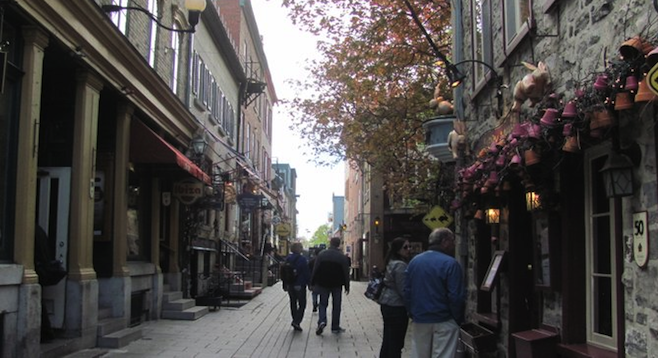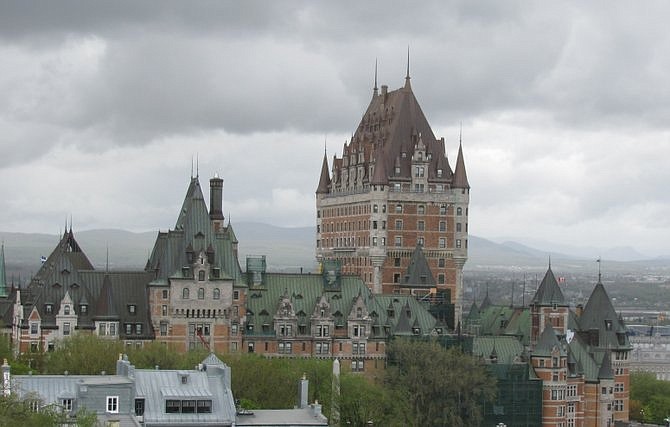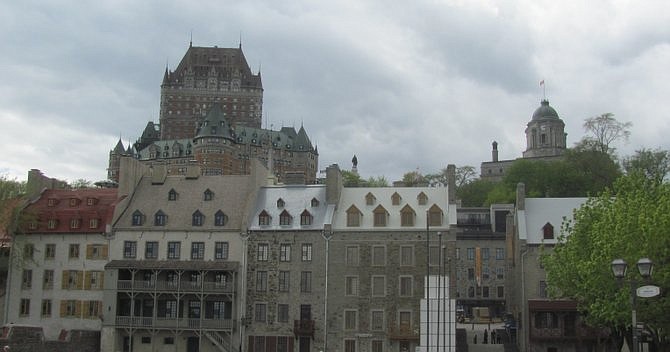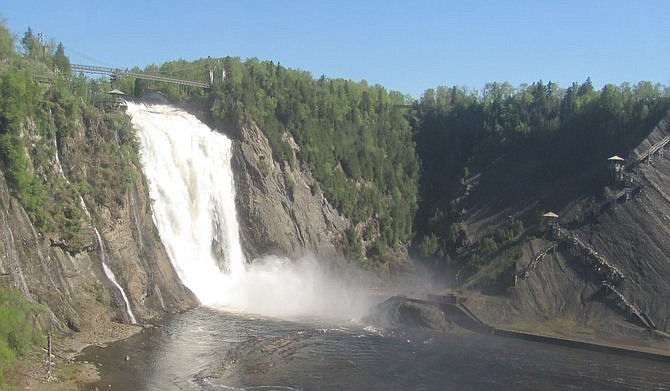 Facebook
Facebook
 X
X
 Instagram
Instagram
 TikTok
TikTok
 Youtube
Youtube

Québec is one of North America’s oldest cities, having been founded in 1608 by famous French explorer Samuel Champlain. It was the capital of New France (French North America) until the British captured it in 1759. Despite over 200 years of rule by first Britain and later an Anglo-leaning Canadian national government, Québec has essentially remained a culturally French city.
Old Québec sits on Cap Diamont, a promontory that over looks the spot where the St. Lawrence River narrows on its way to the Great Lakes. It is split into two parts: the upper city, sitting on the high grounds of the Cape, and the lower city, which is the old port.

Upper Old City
Québec's most recognizable landmark is the 19th-century Chateau Frontenac (left). Designed as a tourist attraction from the beginning, this hotel was built at a much later date than the surrounding old town.
However, like the Eiffel Tower, it has become such an architectural landmark that it's transcended from tourist trap to the symbol of the city. The best place to view the Chateau is the Dufferin Terrace that runs along the cliff edge between the upper and lower old city.
From the Dufferin Terrace, head north to the Cathedral Notre Dame. This 1647 structure is Quebec's main cathedral.
To learn more of the history of Québec City and the French in North America, head next door to the Museum of the French in America. Housed on the ground of the 1663 Seminary of Québec, it tells the story of French settlement in the New World. Admission to the chapel of the seminary is included in admission.
Lower City
The lower town can be accessed from Parc Montmorency via the Escalier Casse-cou (the Breakneck Stairs) or, for those less physically inclined, the Old Québec Funicular, a few blocks south of the park, will get you there with no effort.
Either method will deposit you on the Le Petit Champlain, a tourist street full of shops and restaurants (top). Halfway down Le Petit Champlain, Le Lapin Sauté (the sautéed rabbit) is highly recommended for traditional French Canadian cuisine.

From le Petit Champlain head to Place Royale, the place where Québec City began. Samuel Champlain built a trading house here in 1608; later this area was the main town square. The Place Royal Interpretation center tells the story of this founding in exhibits and a 20-minute movie on the life of Champlain.
A few blocks north of Place Royale is the Museum of Civilization, Québec City’s finest museum. It tells the story of the people of Québec province and the world from prehistoric to modern times in a series of permanent and temporary exhibits.
Montmorency Falls
If you find yourself itching to get out of town and see a little of Québec province’s natural beauty, there's no better way to do so than on a bike.
Québec City has an extensive system of bike trails that extend around and outside the city. The most scenic of these follows the St. Lawrence River northeast out of town. After about 11 kilometers on this trail, you'll come to the majestic Montmorency Falls.

At this spot the Montmorency River drops 84 meters into the St. Lawrence river valley. The falls are 30 meters higher than Niagara, but not near as wide.
The bike trail will take you to a visitor center at the foot of the falls. From there, take a cable car to the top for a fee or hike up 487 steps for free. At the top is a walkway suspended over the falls for an eagle-eye view.
Bottom Line
For a taste of France without the long plane ride, Québec's a great option. It has all the charm and cuisine of a French city – just as much, if not more than Montréal – no further than the U.S. east coast.


Québec is one of North America’s oldest cities, having been founded in 1608 by famous French explorer Samuel Champlain. It was the capital of New France (French North America) until the British captured it in 1759. Despite over 200 years of rule by first Britain and later an Anglo-leaning Canadian national government, Québec has essentially remained a culturally French city.
Old Québec sits on Cap Diamont, a promontory that over looks the spot where the St. Lawrence River narrows on its way to the Great Lakes. It is split into two parts: the upper city, sitting on the high grounds of the Cape, and the lower city, which is the old port.

Upper Old City
Québec's most recognizable landmark is the 19th-century Chateau Frontenac (left). Designed as a tourist attraction from the beginning, this hotel was built at a much later date than the surrounding old town.
However, like the Eiffel Tower, it has become such an architectural landmark that it's transcended from tourist trap to the symbol of the city. The best place to view the Chateau is the Dufferin Terrace that runs along the cliff edge between the upper and lower old city.
From the Dufferin Terrace, head north to the Cathedral Notre Dame. This 1647 structure is Quebec's main cathedral.
To learn more of the history of Québec City and the French in North America, head next door to the Museum of the French in America. Housed on the ground of the 1663 Seminary of Québec, it tells the story of French settlement in the New World. Admission to the chapel of the seminary is included in admission.
Lower City
The lower town can be accessed from Parc Montmorency via the Escalier Casse-cou (the Breakneck Stairs) or, for those less physically inclined, the Old Québec Funicular, a few blocks south of the park, will get you there with no effort.
Either method will deposit you on the Le Petit Champlain, a tourist street full of shops and restaurants (top). Halfway down Le Petit Champlain, Le Lapin Sauté (the sautéed rabbit) is highly recommended for traditional French Canadian cuisine.

From le Petit Champlain head to Place Royale, the place where Québec City began. Samuel Champlain built a trading house here in 1608; later this area was the main town square. The Place Royal Interpretation center tells the story of this founding in exhibits and a 20-minute movie on the life of Champlain.
A few blocks north of Place Royale is the Museum of Civilization, Québec City’s finest museum. It tells the story of the people of Québec province and the world from prehistoric to modern times in a series of permanent and temporary exhibits.
Montmorency Falls
If you find yourself itching to get out of town and see a little of Québec province’s natural beauty, there's no better way to do so than on a bike.
Québec City has an extensive system of bike trails that extend around and outside the city. The most scenic of these follows the St. Lawrence River northeast out of town. After about 11 kilometers on this trail, you'll come to the majestic Montmorency Falls.

At this spot the Montmorency River drops 84 meters into the St. Lawrence river valley. The falls are 30 meters higher than Niagara, but not near as wide.
The bike trail will take you to a visitor center at the foot of the falls. From there, take a cable car to the top for a fee or hike up 487 steps for free. At the top is a walkway suspended over the falls for an eagle-eye view.
Bottom Line
For a taste of France without the long plane ride, Québec's a great option. It has all the charm and cuisine of a French city – just as much, if not more than Montréal – no further than the U.S. east coast.
Comments